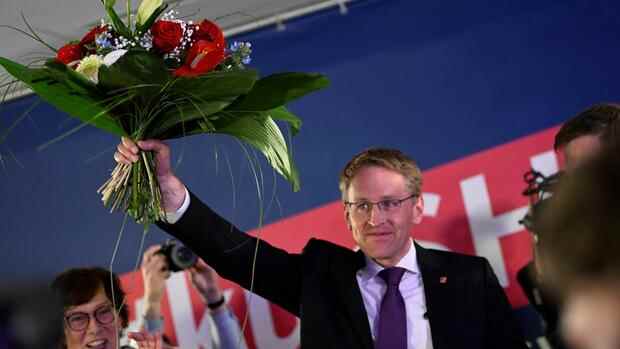According to the ARD extrapolation, the 48-year-old received 42.8 percent of the votes with his CDU – and thus exceeded expectations. That is around eleven percentage points more than five years ago. The distance to the other parties is enormous. Compared to the second strongest force, the Greens, it is almost 26 points.
Günther now has the choice between his two previous coalition partners. The Greens around Finance Minister Monika Heinold got their best result ever in Schleswig-Holstein with 17.2 percent. “There are two election winners: Daniel Günther and the Greens,” said Vice Chancellor Robert Habeck on Sunday evening on ZDF, referring to the CDU Prime Minister.
According to extrapolations, FDP Economics Minister Bernd Buchholz, who is also the top candidate, only got seven percent of the votes with his party and thus lost a lot. However, the FDP would be a better match for the CDU as a partner.
Top jobs of the day
Find the best jobs now and
be notified by email.
After winning the election on Sunday, Günther announced that he wanted to speak to both parties. “We have shaped a new style in Schleswig-Holstein,” he said, praising the work of his previous Jamaican government.
The South Schleswig Voters’ Association (SSW) should not play a role in the formation of the government. The party of the Danish minority gets about six percent of the vote.
SPD remains in opposition
The SPD, with its largely unknown top candidate, former head of the state chancellery Thomas Losse-Müller, remains in the opposition. The traffic light dreams that some people had in Kiel after the federal elections have burst. The decline of the SPD in Schleswig-Holstein continues, they only came to 15.5 percent. Nine years ago she got around 40 percent of the votes.
In view of the developments in recent weeks, the election in Germany’s northernmost federal state has become significantly more relevant, despite the small number of 2.3 million eligible voters.
All graphics >>>
With Russia’s war of aggression in Ukraine and the approaching end of Russian energy imports, the small federal state is moving into the focus of Germany’s security of supply. It’s about the question of how Germany can quickly develop alternative energy sources and produce more green electricity itself.
The federal state is benefiting enormously, especially in the energy sector. Last Monday, Federal Economics Minister Habeck declared that two of the four planned floating terminals for liquefied natural gas (LNG) would be connected “this year”, one in Brunsbüttel in Schleswig-Holstein.
Brunsbüttel is to become an “import hub” for liquid gas, and in future also for “green” hydrogen and for derivatives such as ammonia. And in addition to gas imports, the country generates a lot of wind energy – on land and at sea.
In this respect, the election in Schleswig-Holstein can be classified as a mood test of particular importance for the federal government. The crisis management of the traffic light government, which has been in office for around six months, is obviously ambivalent.
>> Read more: CDU faction leader speaks out in favor of Jamaica coalition – SPD speaks of “debacle”
The Union im Bund around its chairman Friedrich Merz gives the election result in Kiel the perspective of North Rhine-Westphalia’s Prime Minister Hendrik Wüst: “First of all, this is a great success for Daniel Günther, but also for the CDU as a whole,” he said in an interview the Handelsblatt. “The CDU people’s party is back on track,” said Wüst, who has to defend his post in Düsseldorf in the state elections next Sunday.
In North Rhine-Westphalia, however, it is clear that the election will not be as clear as in the north. According to the latest polls, there is a neck-and-neck race between incumbent Wüst and his challenger Thomas Kutschaty (SPD). North Rhine-Westphalia is considered the heart of the Social Democrats. Retaking the State Chancellery would also be an important sign of support for Chancellor Olaf Scholz (SPD).
More: The choice in the news blog
